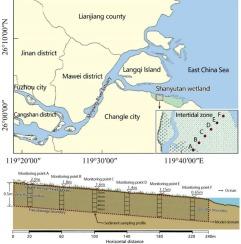河口湿地沉积物中铵态氮和硝态氮运移的数值模拟——以闽江河口为例
IF 6.6
1区 农林科学
Q1 SOIL SCIENCE
引用次数: 0
摘要
河口湿地沉积物中铵态氮(NH4+-N)和硝态氮(NO3——N)的迁移和转化受潮汐波动的影响。然而,目前对该主题的研究主要依赖于野外实验,这些实验耗时且往往缺乏连续性,特别是关于潮汐周期中氮(N)转化的动态变化。本研究以闽江河口湿地为研究区,研究了潮汐作用下沉积物中NH4+-N和NO3−-N的运移和转化。建立了基于HYDRUS的数值模型,仿真精度在可接受范围内。成功地获得了不同潮滩和月份N的转化参数。结果表明,夏季(8月)硝化、矿化和反硝化系数高于秋季(11月),但潮滩位置和土壤深度的季节格局有所不同。在空间上,硝化作用和矿化作用随深度的增加而减小,而反硝化作用则随深度的增加而增加。随着淹没深度的增大,反硝化作用和矿化作用往往呈增加趋势。模型模拟结果表明,沉积物淹没深度和溶质浓度是控制NO3−-N淋溶的关键因素,随着潮位的增加而增加,但有一定的滞后性,特别是在大潮期间,而小潮在中潮滩表现出较大的变异性。本研究为河口湿地沉积物氮输运参数提供了理论见解,并提供了以闽江河口为例的建模方法,有助于河口湿地生态系统的可持续管理。本文章由计算机程序翻译,如有差异,请以英文原文为准。

Numerical modeling of ammonium and nitrate nitrogen transport in estuarine wetland sediments: a case study of the Minjiang Estuary
The transport and transformation of ammonium nitrogen (NH4+-N) and nitrate nitrogen (NO3–-N) in estuarine wetland sediments are influenced by tidal fluctuations. However, current research on this topic primarily relies on field experiments, which are time-consuming and often lack continuity, particularly regarding the dynamic changes in nitrogen (N) transformation during tidal cycles. In this study, the Minjiang Estuary wetland in China was selected as the research area to investigate the transport and transformation of NH4+-N and NO3−-N in sediments under tidal influence. A numerical model based on HYDRUS was developed, and its simulation accuracy was within acceptable limits. Transformation parameters for N at different tidal flats and months were successfully obtained. Results suggested that nitrification, mineralization, and denitrification coefficients tended to be higher in summer (August) than in autumn (November), although the seasonal pattern varied across tidal flat positions and soil depths. Spatially, nitrification and mineralization often decreased with depth, whereas denitrification tended to increase. With greater inundation depth, denitrification and mineralization often showed an increasing trend. Model simulations indicated that sediment inundation depth and solute concentration were key factors controlling NO3−-N leaching, which increased with tidal level but with a certain degree of lag, especially during spring tides, while neap tides showed greater variability at intermediate tidal flat. This study provides theoretical insights into N transport parameters in estuarine wetland sediments and offers a modeling approach exemplified by the Minjiang Estuary, contributing to the sustainable management of estuarine wetland ecosystems.
求助全文
通过发布文献求助,成功后即可免费获取论文全文。
去求助
来源期刊

Geoderma
农林科学-土壤科学
CiteScore
11.80
自引率
6.60%
发文量
597
审稿时长
58 days
期刊介绍:
Geoderma - the global journal of soil science - welcomes authors, readers and soil research from all parts of the world, encourages worldwide soil studies, and embraces all aspects of soil science and its associated pedagogy. The journal particularly welcomes interdisciplinary work focusing on dynamic soil processes and functions across space and time.
 求助内容:
求助内容: 应助结果提醒方式:
应助结果提醒方式:


